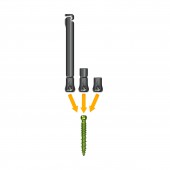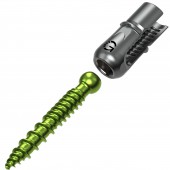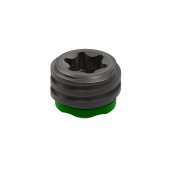
| THE AWARD |
| CATEGORIES |
| REGISTRATION |
| SUBMIT YOUR WORK |
| ENTRY INSTRUCTIONS |
| TERMS & CONDITIONS |
| PUBLICATIONS |
| DATES & FEES |
| METHODOLOGY |
| CONTACT |
| WINNERS |
| PRESS ROOM |
| GET INVOLVED |
| DESIGN PRIZE |
| DESIGN STORE |
| THE AWARD | JURY | CATEGORIES | REGISTRATION | PRESS | WINNERS | PUBLICATIONS | ENTRY INSTRUCTIONS |
Tilock Modular System Spinal Fixation by Genesys Spine |
Home > Winners > Design #69468 >Interview |
 |
|
FS: What is the main principle, idea and inspiration behind your design?
NC: a. The principal behind the TiLock Modular Spinal System is to provide a better way to immobilize and stabilize spinal segments as an adjunct to fusion compared to standard pedicle screw systems. The Modular Design can provide the following benefits i. The Modular Design allows for midline placement of the screws and spinal construct. This requires a smaller incision and less disruption to the muscle and soft tissues surrounding the treatment site. ii. The Modular Design allows the surgeon to place the screws without the heads (tulips) attached. This provides for better visualization during screw placement. iii. Placement of the screws without the heads (tulips) enables screw-to-screw distraction and improving disc space visualization. iv. When revising a standard pedicle screw construct utilization of the TiLock Modular Spinal System allows for surgeons to place screws into virgin bone rather than placing oversized screws into the prior screw holes. v. Compared to minimally invasive pedicle screw procedures the modular approach provides significant advantages to distraction and compression of the disc; thus, overcoming the primary shortcomings of MIS procedures while still benefiting from the reduced tissue disruption and faster patent recovery times. b. At Genesys Spine we always strive produce the most efficient and effective systems to help treat spinal pathologies. Surgeons appreciate the ease of use and we hope that leads to lower incident rates of complications for the patients. c. The inspiration behind the design is to always look to improve the standards of patient care. We feel that the TiLock Modular Spinal System is the next generation of spinal fixation.
FS: What has been your main focus in designing this work? Especially what did you want to achieve?
NC: a. Our focus was to evolve the standard procedure for spinal fixation.
FS: What are your future plans for this award winning design?
NC: We expect the Modular concept to become the new standard of treatment for spinal fixation. As such, we will add peripheral products to support the product line such as the additions of connectors, dominoes, an enhanced cross-link design and other surgical instrumentation.
FS: How long did it take you to design this particular concept?
NC: Genesys Spine spent 15 months of prototyping, testing, and evolving the design.
FS: Why did you design this particular concept? Was this design commissioned or did you decide to pursuit an inspiration?
NC: a. Compared to minimally invasive pedicle screw procedures the modular approach provides significant advantages to distraction and compression of the disc; thus, overcoming the primary shortcomings of MIS procedures while still benefiting from the reduced tissue disruption and faster patent recovery times. This concept includes the best parts of open and minimally invasive spinal fixation procedures. b. The concept and design are entirely developed within Genesys Spine. This was not a commissioned design.
FS: Is your design being produced or used by another company, or do you plan to sell or lease the production rights or do you intent to produce your work yourself?
NC: The product is currently, and will continue to be, produced and sold by Genesys Spine. There are no plans to enter into partnerships or similar agreements at this time.
FS: What made you design this particular type of work?
NC: To improve upon the standard of care for spinal fixation procedures.
FS: Where there any other designs and/or designers that helped the influence the design of your work?
NC: The concept was fully developed internally by the Genesys Spine team using input from our design surgeons.
FS: Who is the target customer for his design?
NC: Neurosurgeons, orthopedic surgeons, and D.O.s.
FS: What sets this design apart from other similar or resembling concepts?
NC: The TiLock Modular Spinal System utilizes simplified instrumentation to perform the procedures. The first Modular systems were difficult to use and had very complex instrumentation.
FS: How did you come up with the name for this design? What does it mean?
NC: TiLock is the name for Genesys Spine’s spinal fixation product lines. Modular comes from the fact the Modular approach to placement of the pedicle screws.
FS: Which design tools did you use when you were working on this project?
NC: SolidWorks (3D CAD design software) and ANSYS (engineering simulation and 3D design software) were used to design, model, and analytically test different concepts. Physical prototypes for testing and evaluation were made using rapid prototyping including 3D printed devices. Physical prototypes were then tested and analyzed so the designs could be evolved.
FS: What is the most unique aspect of your design?
NC: There is an integrated retention ring inside the Tulips that allows the tulips to be pressed on with very little force (<12 lbs) but holds the tulips securely in place. Under worst-case condition each tulip requires more than 1150 lbf to be removed.
FS: Who did you collaborate with for this design? Did you work with people with technical / specialized skills?
NC: We collaborated with a number of different design surgeons for design input and reviews of concepts.
FS: What is the role of technology in this particular design?
NC: Technology played an integral role in the design and development of this product. In a matter of a few days a concept could be designed, analytically tested, refined, prototyped, then physically tested. The use of SolidWorks, ANSYS, rapid prototyping, and 3D printing technology allowed the designed to undergo numerous iterations of development and testing with each iteration producing a stronger, better, and safer design.
FS: Is your design influenced by data or analytical research in any way? What kind of research did you conduct for making this design?
NC: This design did not require a great deal of research. Since spinal fixation system have been used for many years they are well known and well characterized.
FS: What are some of the challenges you faced during the design/realization of your concept?
NC: The primary challenge was designing the integrated retention ring inside the Tulips. This retention ring must allow for the tulips to be easily pressed into position but then hold them securely in place. The integrated retention ring allows the tulips to be pressed on with very little force (<12 lbs) but holds the tulips securely in place; under worst-case condition each tulip requires more than 1150 lbf to be removed. Through cycle after cycle of this project the design was refined countless times.
FS: How did you decide to submit your design to an international design competition?
NC: Genesys Spine takes tremendous pride in the TiLock Modular Spinal System and wanted to be able to show it off to the international community.
FS: What did you learn or how did you improve yourself during the designing of this work?
NC: To never settle for the status quo. Since spinal fixation system have been used for many years they are well known and well characterized. Instead of designing a system like everyone else has Genesys Spine was determined to raise the bar to a new level.
FS: Thank you for providing us with this opportunity to interview you.
A' Design Award and Competitions grants rights to press members and bloggers to use parts of this interview. This interview is provided as it is; DesignPRWire and A' Design Award and Competitions cannot be held responsible for the answers given by participating designers.
| SOCIAL |
| + Add to Likes / Favorites | Send to My Email | Comment | View Press-Release |





